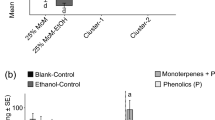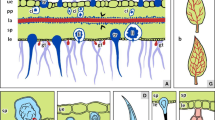Abstract
Podocarpus gracilior is resistant in nature to insect attack. Apparently, the resistance ofP. gracilior is due to a multichemical defense mechanism. Chemicals identified as potential components of the multichemical defense are four norditerpenedilactones, including nagilactones, C, D, and F, which cause insect feeding deterrent activity ultimately coupled to an insecticidal activity, and podolide, an insecticide; two nonlethal growth-inhibiting biflavones, podocarpusflavone A and 7″,4′″-dimethylamentoflavone; and the ecdysis-inhibiting phytoecdysone, ponasterone A.
Similar content being viewed by others
References
Brown, K.S., Jr., andSanchez, W.E. 1974. Distribution and functions of norditerpene dilactones inPodocarpus species.Biochem. Syst. Ecol. 2:11–14.
Brues, C.T. 1946. Insect Dietary. Harvard University Press, Cambridge, Massachusetts, 446pp.
Chan, B.G., Waiss, A.C. Jr., Stanley, W.L., andGoodban, A.E. 1978. A rapid diet preparation method for antibiotic phytochemical bioassay.J. Econ, Entomol. 71:366–368.
Dethier, V.G. 1954. Evolution of feeding preferences in phytophagous insects. Evolution 8:33–54.
Dethier, V.G. 1970. Chemical interactions between plants and insects, pp. 83–103,in E. Sondheimer and J.B. Simeone (eds.). Chemical Ecology. Academic Press, New York.
El-Ibrasky, M.T., Abdel-Hamid, M., andEl-Refai, A. 1976. Ecdysones and plant growth regulators induce solitarious characters and reduce fertility in the desert locust.Enlomol. Exp. Appl. 19(3):214–220.
Elliger, C.A., Chan, B.G., andWaiss, A.C., Jr. 1980. Flavonoids as larval growth inhibitors.Naturwissenschaften 67:358–360.
Feeny, P.O. 1968. Effects of oak leaf tannin on larval growth of the winter moth,Operophtera brumata.J. Insect Physiol. 14:805–817.
Finny, D.J. 1952. Probit Analysis, 2nd ed. Cambridge University Press, Cambridge, England, 318 pp.
Klocke, J.A., andChan, B.G. 1982. Effects of cotton condensed tannin on feeding and digestion of the cotton pest insect,Heliothis zea.J. Insect Physiol. 28:911–915.
Kubo, I.,Wei Lee, Y.,Balogh-Nair, V.,Nakanishi, K., andChapya, A. 1976. Structure of ajugarins,J. Chem. Soc., Chem. Commun. 949–950.
Kubo, L., Klocke, J.A., andAsano, S. 1981. Insect ecdysis inhibitors from the East African medicinal plantAjuga remota (Labiatae).Agric. Biol. Chem. 45:1925–1927.
Kubo, I., Klocke, J.A., andAsano, S. 1983. The effects of ingested phytoecdysones on the growth and development of two lepidopterous larvae.J. Insect Physiol. 29:307–316.
Kubo, I.,Klocke, J.A.,Miura, I., andFukuyama, Y. 1982. Structure of ajugarin IV. J.Chem. Soc., Chem. Commun. 618–619.
Price, P.W. 1975. Insect Ecology. Wiley-Interscience, New York, 514 pp.
Robbins, W.E., Kaplanis, J.N., Thompson, M.J., Shorting, T.J., Cohen, C.F., andJoyner, S.C. 1968. Ecdysone and analogues: Effects on development and reproduction of insects.Science 161:1158–1160.
Russell, G.B., Fenemore, P.G., andSingh, P. 1972. Insect control chemicals from plants. I. Nagilactone C, a toxic substance from the leaves ofPodocarpus nivalis andP. hallii.Aust. J. Biol. Sci. 25:1025–1029.
Sasse, J.M., Kingsley, S.R., andGalbraith, M.N. 1981. Distribution of podolactone-type plant growth inhibitors in the Coniferae.Phytochemistry 20:2195–2204.
Shigematsu, H., Moriyama, H., andArai, N. 1974. Growth and silk formation of silkworm larvae influenced by phytoecdysones.J. Insect Physiol. 10:867–875.
Singh, P., Fenemore, P.G., Dugdale, J.S., andRussell, G.B. 1978. The insecticidal activity of foliage from New Zealand conifers.Biochem. Syst. Ecol. 6:103–106.
Singh, P., Russell, G.B., Hayashi, Y., Gallagher, R.T., andFrederickson, S. 1979. The insecticidal activity of some norditerpene dilactones.Entomol. Exp. Appl. 25:121–127.
Williams, C.M. 1970. Hormonal interactions between plants and insects, p. 114,in E. Sondheimer and J.B. Simeone (eds.). Chemical Ecology. Academic Press, New York.
Author information
Authors and Affiliations
Rights and permissions
About this article
Cite this article
Kubo, I., Matsumoto, T. & Klocke, J.A. Multichemical resistance of the coniferPodocarpus gracilior (Podocarpaceae) to insect attack. J Chem Ecol 10, 547–559 (1984). https://doi.org/10.1007/BF00994220
Received:
Revised:
Issue Date:
DOI: https://doi.org/10.1007/BF00994220




